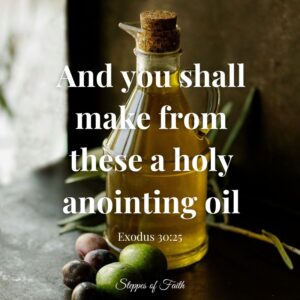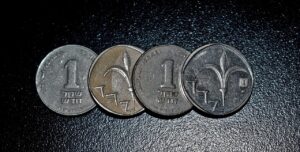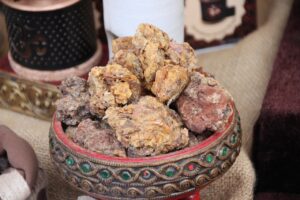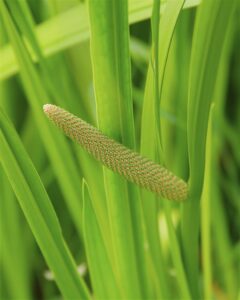
”And you shall make from these a holy anointing oil.” (Exodus 30:25)
Many churches use anointing oil. Catholics use it in many sacramental ceremonies, and certain evangelicals use it when praying for the sick or dedicating babies. Others might use it personally to anoint a new home, car, or other valuable possession. Before He led the Israelites into the Promised Land, God called Moses to the top of Mount Sinai. Among other instructions, He commanded His Jewish leader to create a holy anointing oinone;>l to dedicate the Tabernacle of Meeting, its contents, and the priests overseeing it (Exodus 25-31).
Ceremonial anointing is a sacred event and different from cultural anointing, such as when the prostitute poured out the oil from her alabaster jar and blessed Jesus’ feet (Luke 7:38). In ceremonial anointing, priests use a special oil reserved for religious purposes. Such was God’s anointing oil in Exodus 30. To keep it holy, God provided Moses with an exact recipe.
“Moreover, the LORD spoke to Moses, saying: ‘Also take for yourself quality spices—five hundred shekels of liquid myrrh, half as much sweet-smelling cinnamon (two hundred and fifty shekels), two hundred and fifty shekels of sweet-smelling cane, five hundred shekels of cassia, according to the shekel of the sanctuary, and a hin of olive oil. And you shall make from these a holy anointing oil, an ointment compounded according to the art of the perfumer. It shall be a holy anointing oil.’” (Ex 30:22-25)
The anointing oil had to be a precise blend of priceless aromatics—myrrh, cinnamon, cane, and cassia—measured in exact shekels and mixed with olive oil.

What’s a Shekel?
God commanded Moses to measure out specific shekels of each spice. Ancient peoples used shekels as a measurement of weight. One shekel equaled four ounces (11g) and twenty gerahs. The word gerah was originally a figurative term based on the tiny beans of a carob tree. It later took on the meaning of “grain” or “kernel,” indicating the smallest amount of money.
On the other hand, three thousand shekels equaled one talent, the heaviest and largest unit of measurement in terms of weight and value. Jesus used a measure of talents in His parable in Matthew 25:14-30 concerning the importance of sowing into God’s kingdom and not relying on earthly goods. In the parable, a man gave one servant five talents (15,000 shekels), another received two talents (6,000 shekels), and a third received one talent (3,000 shekels).
The shekel later became a coined currency that Israel still uses today. Its modern worth is equivalent in U.S. dollars to about twenty-five cents. To put Jesus’ parable in Matthew 25 in today’s market, the man gave the first servant $3,750, the second servant $1,500, and the third servant $750.
Moses measured each spice in strict terms of weight for the anointing oil, according to God’s instructions.
500 shekels of liquid myrrh = 200 ounces (12.5 lbs/5.7 kg; 1.45 gallons)
250 shekels of cinnamon = 100 ounces (6.25 lbs/2.83 kg)
250 shekels of cane = 100 ounces (6.25 lbs/2.83 kg)
500 shekels of cassia = 200 ounces (12.5 lbs/5.7 kg)
Moses mixed all these spices with “a hin” of olive oil (v25). “A hin” equals one gallon. With such a high concentration, the anointing oil became almost like an ointment rather than thin and runny. Each ingredient is considered a “chief ingredient ” (Song 4:14).” But each holds unique symbolism as a part of the holy anointing oil.
The Chief of the Chief Oil Ingredients
The anointing oil’s principal ingredient is myrrh (“bitter”). Myrrh is a gum resin (sap) taken from a tree that resembles acacia, a tree found in Africa and Saudi Arabia. Another variety is native to Syria.
Myrrh is initially an oily substance that hardens over time if applied to certain surfaces, such as wood or stone. When handled by a perfumer, it becomes an oil-based fragrance with a strong, sweet smell. Genesis 37:25 indicates it was very popular in the spice trade, yet God commanded Moses to use only the initial oil, the more expensive “liquid myrrh.”
The Bible mentions several different uses for myrrh besides anointing.
Perfume. In the book of Esther, the women used it as a perfume as part of their year-long preparation to meet King Ahasuerus (Est 2:12). Psalm 45:8, Proverbs 7:17, and Song of Solomon 1:13 and 3:6 state a similar use.
Love. Song of Solomon 4:14 mentions myrrh and other prized spices as symbols of love and joy within marriage.
Gifts. Luke 2 recalls the wise men bringing gifts of gold, frankincense, and myrrh to Jesus shortly after His birth. Gold symbolized God’s holy temple, frankincense represented Israel’s worship, and myrrh signified anointing. In Greek, Jesus is the Christ (“christos”), and in Hebrew, He is the Messiah (“masiah”). Both mean “anointed one.” Therefore, they used myrrh to anoint the “anointed one.”

Myrrh Isn’t Always Good
Myrrh did not always serve a positive role. People also used it in times of suffering or upon death.
Desensitizing. As the Roman guards led Jesus to the cross, they offered Him sour wine mixed with “gall,” another word for myrrh. Myrrh covered the sour wine’s taste and offered an opium-like effect to deaden one’s senses. Jesus refused it (Mt 27:33-34). This sour wine differs from the one offered to the Lord as He hung on the cross. That was a cheap wine commonly used by soldiers as a torture device to prolong life and increase suffering (Lk 23:36; Jn 19:29).
Embalming. All four New Testament gospels record Joseph of Arimathea and Nicodemus using myrrh to anoint Jesus’ body following His death on the cross (Mt 27:57-60; Mk 15:42-26; Lk 23:50-54; Jn 19:38-40). Myrrh helped to cover the stench of a decaying body.
Persecution and Promise. In Revelation 2:8-11, Jesus writes to the second church of Asia, the Church in Smyrna. “Smyrna” is a Greek translation of myrrh. He describes it as “persecuted,” suffering because of its faith, but He notes the church’s endurance and spiritual richness. He encourages the people to “be faithful until death, and I will give you the crown of life.”
Regardless of use, even if it appears negative, myrrh symbolizes God’s blessing and promised reward. Others rightly interpret it as turning something bad into something good or better than it was. It becomes holy and set apart for Him, enjoying His favor.

Oil and Romance
The second ingredient in God’s anointing oil is cinnamon, translated from the Latin Cinnamomum verum, meaning “true cinnamon.” The type listed in Exodus 30 grows in Malaysia, but its finest quality is found only in Sri Lanka (“Ceylon,” Rev 18:13). Its distant cultivation indicates the existence of an extensive trade route between Israel and eastern nations.
Growing about 20-30 feet (6.1-9.1m) high, thin strips of the tree’s inner bark (curling as they peel) and the crushed nut are boiled to create a pungent, fragrant oil. Ancient pagan cultures sometimes used cinnamon in their funerary and religious practices, believing its aroma protected them from evil spirits while providing an expensive offering to their gods. More commonly, they used it for medicinal purposes because of its anti-inflammatory and antibacterial qualities.
Besides Exodus 30:23, Proverbs also mentions cinnamon, where Solomon describes the danger of giving into a harlot’s seduction. Only such women could afford such a valuable spice.
“I have perfumed my bed with myrrh, aloes, and cinnamon. Come, let us take our fill of love until morning; Let us delight ourselves with love.” (Prov 7:17-18)
Solomon refers again to cinnamon in Song of Solomon to signify love, romance, and marriage, naming it among the “chief spices.”
“With pleasant fruits, fragrant henna with spikenard, spikenard and saffron, calamus and cinnamon, with all trees of frankincense, myrrh, and aloes, with all the chief spices.” (4:13-14)
Scripturally, cinnamon symbolizes abundance, love, purification, and beauty. And because it was so rare and expensive, it also symbolizes God’s holiness and majesty.
Honor and Affection
The third ingredient in God’s anointing oil is cane, a plant originating in India and ancient Yemen. The Latinized Greek version is “calamus” or “calmus.”
According to Easton’s Bible Dictionary, cane is “a tall sedgy plant with a hollow stem” that grows in wet areas of China. Some Bible translations render it as “reed,” indicating its weak and fragile nature. Perfumers cut and dry the stalk, remove the web-like pith inside, reduce it to powder, and mix it with ointments. Today, it is better known as sweet flag, muskrat root, or sway plant.
Isaiah 43:24 and Jeremiah 6:20 both refer to it as “sweet” and “aromatic” cane, respectively. The Bible also mentions cane/calamus in Song of Solomon 4:13-14 (see above) and Ezekiel 27:18-19.
Aside from being a prized spice, Isaiah 43, Jeremiah 6, and Ezekiel 27 indicate that cane is a sign of blessing and honor, while Solomon denotes it as a symbol of affection.

The Last Oil Ingredient
Cassia, or Cinnamomum cassia, is the last ingredient in holy anointing oil. Like cinnamon (Cinnamomum aromaticum), its bark is peeled, boiled, then powdered to create an ointment. It has a darker color, thicker texture, and weaker scent than cinnamon, making it ideal for the common market (Ezekiel 27:19).
A third type of cassia called Cassia ligra of China is sometimes substituted for true cinnamon. Some believe this is the true cinnamon of the Bible, but Exodus 30 indicates they were two different plants.
In addition to ointment, Psalm 45 mentions using cassia as a fabric scent for a king’s robes.
“Myrrh, aloes, and cassia perfume all your garments.” (Ps 45:8)
Here again, the Bible mentions cassia among the more expensive spices of its day. Biblically and spiritually, it symbolizes God’s connection with man and His holiness and honor as the one true God.
God’s anointing oil offered a sweet fragrance of worship, majesty, blessing, honor, affection, and purity. It had one unique purpose—to dedicate His temple and priests to Him and declare them holy in His sight. They were set apart for His specially appointed purposes and received His favor.
People may use anointing oil today, but unless it is of the exact measurement and contains the exact ingredients set forth by the Lord Himself in Exodus 30, it is only ordinary oil. God demands His anointing oil to be holy, pure, absolutely unadulterated, and used solely for His holy purpose. Using anything different or for any other intention erases its holy significance and is entirely unacceptable, risking the penalty of death (Ex 30:33).
[READ MORE: The Symbolic Meanings of 7 Trees in the Bible]